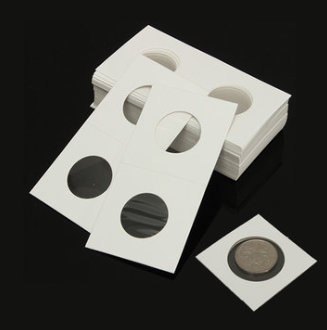Preparing Your Coin Collection for Sale
•  Buy the most current edition of R.S. Yeoman’s “A Guide Book of United States Coins,” which is also known as “The Official Red Book”. Spread out your collection and see if you can match your coins to the book’s examples. This is a quick and easy way to give you a general sense of which coins are valuable and which are not.
Buy the most current edition of R.S. Yeoman’s “A Guide Book of United States Coins,” which is also known as “The Official Red Book”. Spread out your collection and see if you can match your coins to the book’s examples. This is a quick and easy way to give you a general sense of which coins are valuable and which are not.
• If you’re a fairly advanced collector, go ahead and list the mint mark and date on each coin’s holder, or in your coin album. But if you’re not entirely sure how to grade collectible coins, it’s probably best to skip that step altogether. Instead, keep a separate list (in a notebook, for instance) of the Red Book and/or Grey Sheet values for your coins, along with your best estimation of their grade.
• While the majority of family coin collections are not rare, plenty have been taken out of circulation and do have significant value. Look on the original flaps of the old coin holders (and if they exists, look at the collection’s notes and receipts) to determine when the coins were purchased and how much was paid.
• If your parents or grandparents dealt with certain leading coin dealers of yesteryear who well-respected numismatic figures, there is a greater chance that the collection contains a valuable coin. Look at the paperwork to see if the coins were purchased for a premium when your family bought them. If your coins are fairly old and your parents paid a sizable amount of money for them, there is a decent chance that there might be a rarity among them.

• Many coin industry experts believe that it sometimes helps to move your collection from low-cost folders into 2×2 coin holders, like those shown at right. This is especially true of coins in low-cost folders such as the Whitman type, where one presses each coin into a small hole in cardboard.
• There is an argument to be made that presenting a coin in its own distinct space will make it appear more valuable. Sometimes using 2×2 holders can boost an incomplete collection’s value just because it saves the dealer time. He won’t have to transfer your entire collection from a folder into his own 2x2s, and as result he might pass on some of the savings to you.
Shopping Your Collection Around
• Once you’ve gauged the general value of your coins, take them to multiple coin dealers. Never take the first offer. Although most coin dealers are honest, you might enter into the wrong shop on your first visit and be fleeced. You could have a rare coin—like a 1894 S Barber Dime, say—and not realize its true value, only to sell it to an unscrupulous dealer who flips it for plenty more than whatever he paid you.
• Anyone who owns old coins, in fact, should be aware that “missing” coins, like the S Barber Dimes, can be worth upwards of $1 million dollars if they’re in excellent condition. So do your homework and field multiple offers before surrendering your coins.
• Anyone with a complete coin collection stored in albums or folders should leave them right where they are. Keep them secure in your albums to preserve their condition and make them appear more attractive to prospective buyers.
How Your Collection Will Be Appraised
• If you have a partial collection, dealers will sometimes make a very quick decision regarding the collection’s value. That’s because coin buyers typically see the same types of coins each month, and can often rattle off a price quote without much thought. Most will take a quick glance at the folder and determine a fair value of the collection according to the spots that are empty; the the same four or five key coins tend to be missing from just about every partial collection. (These are the rare coins that are typically referred to as the “keys” in the industry.)
• Dealers usually take longer to analyze full coin collections in order to determine a proper value. However, if you have a fairly common collection that dealers see on a consistent basis, such as the Dansco albums, it might not take long to determine value. This is especially true of dealers who have memorized the collection’s key dates.


